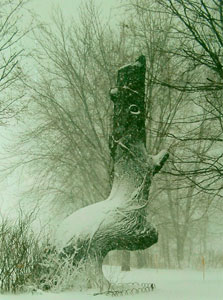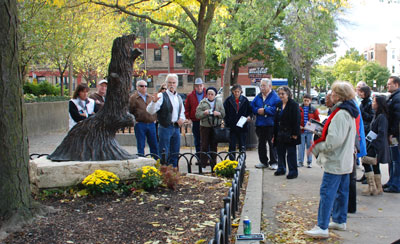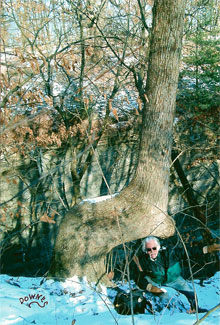The Author's research on
the Native American Marker Trees has been ongoing for nearly three decades, taking him to countless
ancient Native American sites. Early on in his research, he felt that the only way to properly
study this unique phenomenon was to conduct field research at these sites, in hopes of finding
either significant information regarding the many uses of the Trail Maker Trees or ideally, an
actual living specimen. Dennis Downes has given over 150 lectures on the Trail Marker Tree System
at museums, libraries, historical societies, and community centers across the country, as well as
in the United Kingdom and Canada; distributing his brochures on the subject and showing his bronze
sculptures and photographic exhibit on both past and present Trail Maker Trees of the Great Lakes
Region and beyond. Mr. Downes was fortunate to come from a state that has been aware of the
historical significance of the Trail Marker Trees for well over a century and has helped to keep
this knowledge alive. The state of Illinois is where much of the earliest research and
documentation of Trail Marker Trees began, as early as 1836. Some of the groups involved with the
first studies of the Trail Marker Trees are the Chicago Academy of Sciences, Daughters of the
American Revolution, Wisconsin Archeologist, Winnetka Historical Society, and the Wilmette
Historical Society. Along with these groups, many individual historians, arborists, landscape
architects, and Trail Marker Tree enthusiasts conducted early research regarding the Trail Marker
Trees. Without the afore mentioned groups the Author never would have been introduced to the Trail
Marker Trees as a boy, which ultimately changed the direction of his life. One of Downes'
earliest influences was his Native American aunt; later in life he has been able to collaborate
with numerous Native American tribes from across the country. At an early stage of Mr. Downes'
study, it was clear to him that he would have to personally go to all of the locations that were
mentioned in these earlier studies as a starting point to his more expansive research study.
The Trail Marker Trees as well as the Marker Trees
in general, were part of an extensive land and water navigation system in our country that already
was in place long before the arrival of the first European settlers. While the Native
American's had a widespread trail system in place, the Trail Marker Trees served as exit signs
off of these land and water routes bringing them to areas of specific interest and then directing
them back to the main route, much like the exit signs off of our major interstates today.
Remembering that before the concept of drainage ditches and canals, to relieve flooding, much of
the country was flooded for long periods. In the spring and the summer paths near rivers and creeks
would not be visible when water overflowed the banks. Trail Trees high on the banks could still be
spotted telling the travelers where to exit the waterway to reach their destination.
Some of these trees would have brought them to
fresh water springs, the preferred source of water used by the Native Americans and settlers alike.
Other Trail Marker Trees would have guided them to areas with exposed stone and copper deposits
needed for their adornments, hunting implements, and everyday tools. Yet, others would lead them to
the areas where they could gather medicinal plants as well as plants used to make their dyes and
paints. The Trail Marker Trees would have taken them to ceremonial sites and occasionally the
burial sites of their ancestors. Also, in relation to the rivers, these trees would indicate areas
of portage and safe crossing (fords). All of the above mentioned reasons for the Trail Marker Trees
made them a necessity to some of the Native Americans' way of life and survival. The widespread
trails created by animal migration that they followed never would have taken them to these many
specific sites of human interest and necessity.
The necessity to be able to identify an actual man
made Trail Marker Tree versus a tree simply deformed by nature would have been extremely important.
The many different shapes of these Trail Marker Trees were distinct in their appearance, and always
followed some specific guidelines. Typically, the types of trees chosen for this purpose came from
the hardwood species, known for their longevity and their flexibility while young, followed by
their permanence to retain these shapes long into the future. However, the Trail Marker Trees
shaped by different Native American Tribes in different regions of the country would have some
variability. To see examples of Trail Marker Trees please go to the Trail Tree Photo's page.
As Mr. Downes' research continues he is able to
find out more about this little known phenomenon in our own back yards. He has devoted a large part
of his life to the study of the Trail Marker Tree System and hopes that these quickly disappearing
culturally altered living landmarks will never be forgotten. Over the years, Downes' artwork
has helped to fund his continued study of the Trail Marker Trees, as well as giving him the
opportunity to create both paintings and sculptures to commemorate these historic landmarks. These
Trail Marker Trees are all too quickly becoming an endangered species.
"After having seen Dennis Downes' beautifully revealing exhibit of
Indian Tree Trail Markers -plus his expert and haunting related art work - I am truly impressed
that one man has taken it upon himself to educate and enlighten us on the splendor and importance
of these rapidly disappearing symbols of Native America. Downes has obviously spent untold hours
making this part of his life's work."
~Janet C. Davies~
190 North Host/Executive Producer
Entertainment Reporter ABC7 news
February 21, 2008
Mr. Downes would like to thank the many Native Americans, archaeologists,
ethnologists, arborists, state and county forest workers, historians, and researchers who came
before him that have contributed to this study.
contact us by email: research@greatlakestrailtreesociety.org
contact us by phone: 847.395.8875


